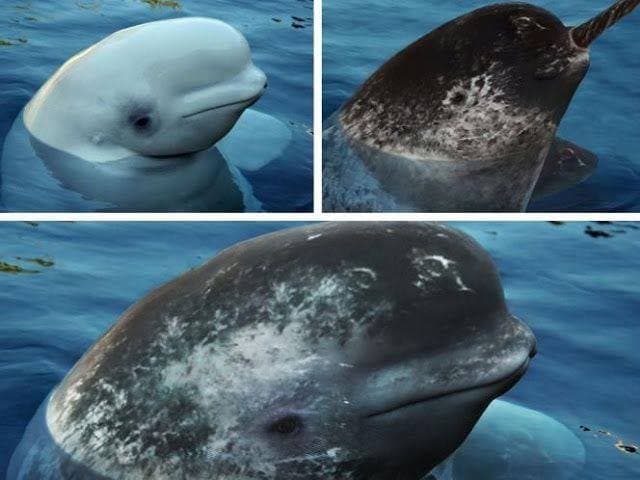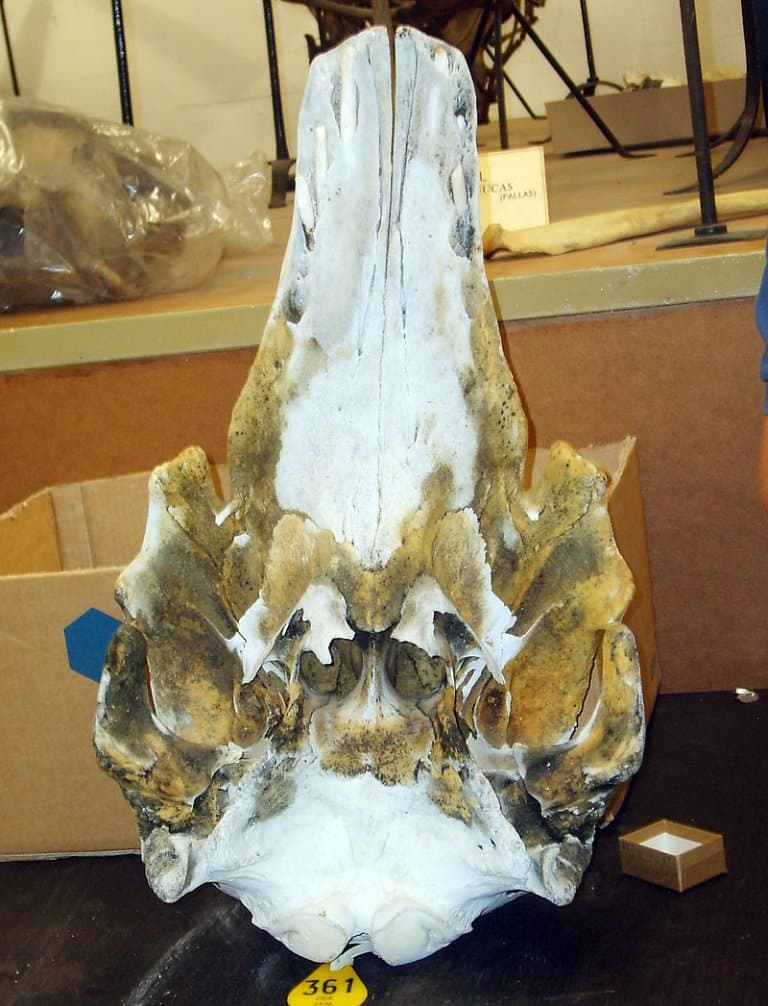Narluga Profile
A lot of strange stuff goes on unwitnessed beneath the Arctic sea ice. The animals who live there are some of the least studied in terms of behaviour, so very little is known about what they do and what they’re into.
But evidence does occasionally surface of deviant acts; the result of a forbidden engagement. And when a beluga and a narwhal love each other very much…
A Narluga is a hybrid whale born from the mating of a female narwhal and a male beluga whale.

Narluga Facts Overview
| Habitat: | Cold Arctic waters |
| Location: | Around Greenland |
| Lifespan: | Unknown |
| Size: | Unknown |
| Weight: | Unknown |
| Color: | Uniform grey |
| Diet: | Unknown |
| Predators: | Humans, polar |
| Top Speed: | Unknown |
| No. of Species: |
N/A |
| Conservation Status: |
N/A |
A Narluga is not so much surprising as it is hard to find.
Cetaceans are well known for their ability to hybridise, but until recently there was no evidence of two of the Arctic’s most famous residents doing the deed.
But a skull found in the shed of a subsistence farmer in Greenland has provided researchers with the hard evidence of a narwhal and a beluga spawning offspring.
It’s the only evidence left in existence, so it brings with it plenty of mysteries and creates a fun game of guessing how it might have lived its life.
This Narluga had some peculiar crosshatched traits in its skull between its mother and father, and this may have given it unique abilities.
Interesting Narluga Facts
1. Hybrid names are usually determined by the father
As a society, we’ve imprinted our patriarchal conventions onto every facet of our lives. To the point that, when it comes to naming hybrid whales (or any hybrid animals) the male species forms the first half of the word.
Ligers, therefore, are products of male lions and female tigers. In tigons, it’s the opposite.
So, a Narluga is the offspring of a male Narwhal and a female Beluga. This naturally implies there’s a Belwhal out there somewhere.
2. Narlugas are exceptional
Aside from being weird and elusive, the name Narluga comes from the first specimen to be found.
This turned out to be born of a Narwhal mother, so the name defies convention, but as a testament to equity and catchy names, the tag has stuck. 1
3. They might be very rare
The individual that was established as a narwhal-beluga hybrid was one of only three such found, ever. Each of these whales was killed by the same hunter, from the same group, and may have been siblings.
This scarcity of samples makes it hard to draw any conclusions about their lives, and only a single skull remains for study. This skull had some very curious characteristics, though, that may give some cues as to how the Narluga spent its life.

4. Their teeth are odd
The family of Narwhales and belugas, Monodontidae, literally means “one tooth”, which is accurate enough for the Narwhal, but is a bit misleading for the beluga.
Narwhals really only have one big tooth. Technically, they have two canines, but one stays deeply embedded in the jaw, while the other spirals forward as the iconic protruding tusk.
There are a couple of useless vestigial teeth behind those, but they’re so small we can safely ignore them.
These whales feed by sucking up squid and soft fish, unable to chew. In contrast, beluga whales have about 34 teeth, more or less evenly distributed across their mouths. They can eat more or less anything with these teeth, ranging from crabs to large fish.
The Narluga skull comes with 18 teeth, and they are something between the two. They’re forward-pointing, and have a slight spiral to them, like the narwhal’s tusk. So, what did these hybrids eat? 2
5. They may have been bottom-feeders
Some speculate that due to the weird protruding teeth, these Narlugas had unusual feeding strategies.
There are some similarities in the chemical composition of their teeth to that of walruses, who dive down and disrupt prey from beneath the mud. The analysis of the teeth suggested it has a different diet than either of its parents.
Their teeth don’t look particularly good for catching fish like a Beluga, and they may have gotten in the way of the suction-feeding techniques seen in Narwhals, so their very physiology might have created a need to find unique ways to get their dinner.
One thing is certain, though, their father was attractive enough to pull it off, despite having no tusk.
6. Narwhals might not care as much about tusks as we thought
Both Beluga and Narwhals live in some very chilly places. Not only that, they’re often covered in sea ice, so we don’t know much about them or their mating behaviours at all.
It’s been assumed that the enormous tusk of a narwhal is a secondary sexual characteristic; something which is selected for by the female based on how glorious it is.
But, for a female narwhal to mate with a tuskless beluga suggests that this tusk isn’t entirely necessary.
7. They could be a sign of worsening conditions
The habitats of beluga and narwhals clearly overlap, and this isn’t necessarily a bad thing. However, if hybridisation events are occurring as a result of less and less ice cover for the species involved, it could reduce their fitness.
Narwhals have been spotted swimming along with pods of beluga whale, something which isn’t common, but does occur enough to be documented. Whether this will result in a Narluga down the line remains to be seen, but with researchers tracking the pod, we might soon find out.
We don’t know if the Narluga was fertile, or even if it was healthy. With a sample size of one, it’s difficult to extrapolate anything, and when that sample is limited to a single skull, there are far more questions than answers.
However, if the Narluga was an infertile offspring, it will be taking valuable resources from the population with no chance to pass on its genes, reducing the fitness of both species. As it is, it remains to be seen whether this is a common event or a strange fluke. 3
8. Beluga whales have been reported to adopt a stray narwhal
Having strayed far from its Arctic habitat, a juvenile narwhal joined a pod of beluga whales. This suggests that these cousins are quite comfortable in each others company.
Narluga Fact-File Summary
Scientific Classification
| Kingdom: | Animalia |
| Phylum: | Chordata |
| Class: | Mammalia |
| Order: | Artyodactyla |
| Family: | Monodontidae |
| Hybrid: | Delphinapterus D. leucas × Monodon M. monoceros |
Fact Sources & References
- (2019), “Hybridization between two high Arctic cetaceans confirmed by genomic analysis“, Nature Scientific Reports.
- “For a dentist, the narwhal’s smile is a mystery of evolution“, Smithsonian Institution.
- Elizabeth Gamillo (2022), “Adopted Lone Narwhal Traveling Among Belugas Could Produce Narluga Calves“, Smithsonian Magazine.
